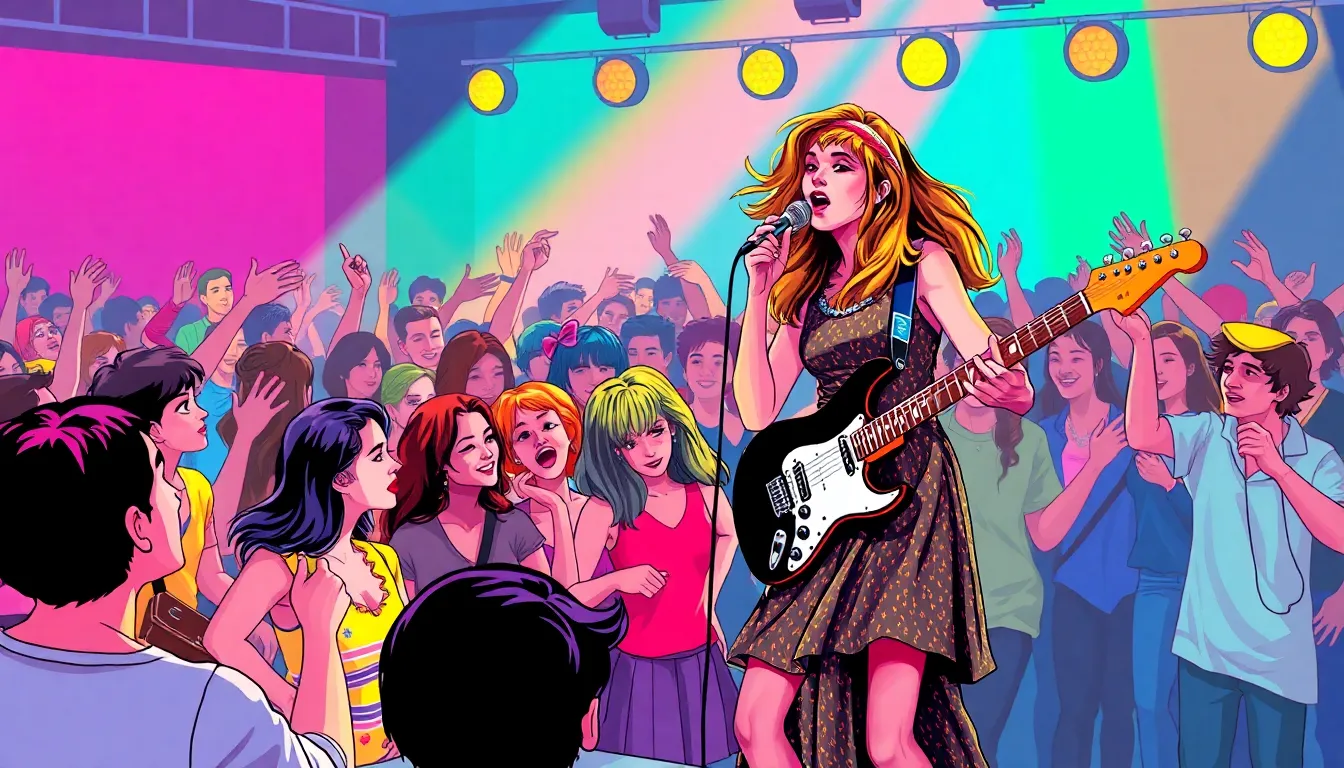Table of Contents
ToggleThe 1960s was a decade like no other, bursting with vibrant colors, revolutionary ideas, and unforgettable tunes. It was a time when the world danced to the beat of rock ‘n’ roll while questioning authority and embracing change. From the groovy styles of bell-bottoms to the iconic music festivals, pop culture in the ’60s was a wild ride that shaped generations.
Overview of Pop Culture in the 1960s
The 1960s marked a significant shift in pop culture, characterized by social change and artistic innovation. This decade produced memorable music, fashion, and protests that influenced future generations.
Key Influences on the Era
Rock ‘n’ roll emerged as a dominant force, with artists like The Beatles and Bob Dylan shaping musical landscapes. The Civil Rights Movement and counterculture movements challenged societal norms, promoting messages of peace and love. Television became a primary medium for entertainment, introducing shows like “The Andy Griffith Show” and “Star Trek.” This blend of music, ideological shifts, and visual media captured public attention, encouraging a spirit of rebellion and self-expression.
Major Events Shaping Culture
Iconic events defined the 1960s, including the Woodstock Music Festival of 1969, which celebrated peace and music. The assassination of President John F. Kennedy in 1963 shocked the nation, altering public sentiment. The Moon landing in 1969 united viewers across the globe, showcasing technological achievement. Protests against the Vietnam War galvanized youth and fueled cultural changes, making the decade memorable for significant social movements.
Music Revolution

The 1960s marked a significant transformation in the music scene, characterized by groundbreaking sounds and cultural shifts. This era fostered creativity, with artists challenging conventions and shaping the soundtrack of a generation.
Iconic Artists and Bands
The Beatles revolutionized the music landscape, pushing boundaries with innovative melodies and lyrical depth. Bob Dylan brought folk music to the forefront, addressing societal issues through his poignant songwriting. Other influential figures included Janis Joplin, known for her powerful voice, and Jimi Hendrix, whose guitar skills redefined rock music. Each artist contributed uniquely to the evolving soundscape, capturing the spirit of the times.
The Rise of Different Genres
Various genres surged during the 1960s, reflecting the diverse cultural climate. Rock emerged as a dominant force, while folk music connected with social movements. Additionally, psychedelia introduced experimental sounds and visuals that captivated audiences. Motown brought rhythm and blues to mainstream charts, featuring artists like The Supremes and Marvin Gaye. Each genre resonated with the public, marking a cultural shift that influenced future musical trends.
Fashion Trends
Fashion in the 1960s showcased a dynamic range of styles, revealing the spirit of liberation and creativity that characterized the decade. Iconic pieces emerged as cultural symbols, influencing not only personal expression but also societal views.
Popular Styles and Icons
Mini skirts, shift dresses, and bell-bottom pants defined this era, with designers like Mary Quant and André Courrèges leading the movement. Youth culture inspired vibrant colors and bold patterns, with psychedelic prints becoming especially popular. Influencers such as Twiggy and The Beatles shaped trends through their distinct styles, engaging the public. Accessories like statement jewelry and go-go boots completed the looks and added flair to everyday outfits.
Impact of Fashion on Society
Fashion in the 1960s acted as a reflection of the broader social changes occurring during the period. Clothing choices often symbolized rebellion against traditional norms, with many embracing unconventional attire. The rise of counterculture groups popularized anti-establishment styles, making fashion a statement of identity and ideology. Additionally, the emphasis on self-expression in fashion paralleled movements advocating for civil rights and women’s liberation, highlighting a shared desire for freedom and individuality.
Television and Film
The 1960s revolutionized television and film, significantly impacting popular culture. This era saw a surge in creative programming and cinematic innovation.
Notable Shows and Movies
Programmers introduced notable shows like “The Andy Griffith Show,” which captured small-town life, and “Star Trek,” which explored futurism and diversity. Films such as “Easy Rider” challenged social norms and reflected counterculture themes. Movies like “The Graduate” featured iconic performances that resonated with young audiences. Popularity soared for sitcoms and dramas, offering reflections on contemporary issues. The engagement with socially relevant narratives defined the decade’s viewing experience.
The Role of Media in Shaping Culture
Media played a crucial role in shaping cultural conversations during the 1960s. Television news coverage of events, including protests and the Moon landing, provided widespread visibility for significant issues. Programs began to incorporate social topics such as civil rights, feminism, and anti-war sentiments. Advertisements mirrored changing attitudes, promoting products that aligned with youth culture and progressive ideals. This engagement created a platform for dialogue, influencing public perceptions.
Social Movements and Their Influence
The 1960s experienced dynamic social movements that reshaped cultural landscapes. These movements profoundly influenced music, fashion, and media.
The Counterculture Movement
Counterculture emerged as a significant force, challenging mainstream norms. Young people sought alternative lifestyles, often rejecting consumerism and authority. They embraced peace, love, and communal living, which resonated through music and art. Festivals like Woodstock showcased this spirit, gathering thousands in celebration of unity and expression. Iconic musicians like Jimi Hendrix and Janis Joplin became symbols of this movement, articulating its values through powerful performances. Their lyrics often addressed societal issues, amplifying the movement’s message and inspiring future generations.
Civil Rights and Its Reflection in Pop Culture
The Civil Rights Movement played a crucial role in shaping pop culture during the 1960s. Activists fought against racial injustice, inspiring artists and entertainers to address these issues in their work. Music became a vital outlet, with songs like Bob Dylan’s “The Times They Are A-Changin’” pushing for social change. Popular television programs and films also highlighted civil rights struggles, engaging audiences in meaningful dialogue. Prominent figures like Martin Luther King Jr. influenced public consciousness, forging connections between activism and art. This intersection of art and activism profoundly impacted society, encouraging greater awareness and advocating for equality.
The 1960s stand as a pivotal decade in pop culture history. Its blend of music fashion and social movements created a vibrant tapestry that continues to influence today’s cultural landscape. The revolutionary spirit of the era fostered artistic innovation and challenged societal norms, leaving a lasting impact on music and fashion.
Television and film also played critical roles in shaping public consciousness, reflecting the dynamic social changes occurring at the time. As the youth embraced new ideas and forms of expression, they sparked conversations that transcended generations. The legacy of the 1960s remains a testament to the power of creativity and activism in shaping a more inclusive and expressive world.




